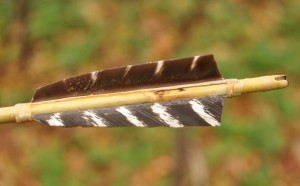Photography courtesy of Lowell Washburn, all rights reserved.
By four in the morning, the wind had completed its shift to the southeast. With fair skies and mild temperatures, it seemed like a perfect day to take up the bow and try for a buck. Although I had two tree stands that would have been fine for that breeze, I decided to hunt from a pop up ground blind instead. For me, the hunt is always twice as exciting when you’re eyeball to eyeball with game as opposed to looking down from an elevated perch.
Setting my blind along a grass strip that separated oak timber from standing corn, I made no attempt to conceal the portable structure. I’ve learned from painful experience that white-tailed deer hate surprises – especially when they occur at close range. I’ve enjoyed my best hunting success by just setting up in the wide open; placing the blind where approaching deer can see it from a long way off. Once the blind was in place, I had one more task to complete. Since accurately gauging distance in the half-light of dawn can be extremely deceiving, I used a single milkweed stem to make a ten-yard marker. Marker in place, I crawled inside the blind to begin my hunt.
The first order of business was to make sure my equipment was ready to go. I was carrying a longbow made for me by northeast Iowa bow maker, Scott Rentschler. Pulling 48 pounds at full draw, the bow has become one of my favorite straight shooters.
My quiver was loaded with arrows crafted from scratch by Florida’s Ryan Gill. Constructed from river cane and fletched with Osceola turkey feathers, the arrows were tipped with 80 grain stone broadheads. A widely recognized expert at making and utilizing Stone Age tools of all types, Gill’s finished stone arrow points have edges so scary sharp that they can barely be touched. Although most modern-day archers would scoff at my low-tech Stone Age equipment, wooden bows and stone points have been successfully bringing down game for untold centuries. I hoped it would do the same today.
When daylight finally arrived, the sunrise was brief but colorful. But although the autumn weather proved ideal, the hoped-for deer were no shows. If there really were any white-tails nearby, they all appeared to be staying inside the standing corn or in the thick understory of the oak timber. The action suddenly improved when sometime past 8:30, I spotted my first deer – a sleek young buck with a modest rack. The deer continued down the grass waterway until it ended up standing at my milkweed range marker. It was an amazing scene as the deer appeared totally oblivious to my blind yet fully realized that the single milkweed was out of place. Eventually growing bored, the buck started to walk away and then stopped again at about 20 yards. Still clueless that anything was amiss, the deer returned for a second time.
There was no rush to grab the bow. In my mind, I had already made the decision to let him walk. It was still early in the season and holding out for a real wall hanger seemed a better option. But somewhere along the line, I must have had a change of heart. Maybe it would be a good morning to hang some venison after all. Trading camera for bow, I began putting tension on the string. Bringing the bow to full draw, I released the arrow and watched as the stone point disappeared into an imaginary “X” on the white-tail’s rib cage. The deer bolted and quickly disappeared.
The hit was good, and I figured the fleeing deer should have been dead within seconds. Nevertheless, I waited for a full five minutes before attempting a recovery. Following the sign, I spotted a suspicious form several yards ahead. Sure enough, it was the buck. Lying in heavy cover, the white-tail was stone dead.





 Tom Cope
Tom Cope Sue Wilkinson
Sue Wilkinson Susan Judkins Josten
Susan Judkins Josten Rudi Roeslein
Rudi Roeslein Elyssa McFarland
Elyssa McFarland Mark Langgin
Mark Langgin Adam Janke
Adam Janke Joe Henry
Joe Henry Kristin Ashenbrenner
Kristin Ashenbrenner Joe Wilkinson
Joe Wilkinson Dr. Tammy Mildenstein
Dr. Tammy Mildenstein Sean McMahon
Sean McMahon